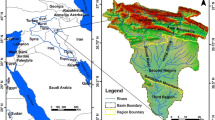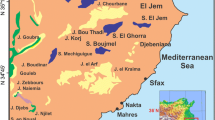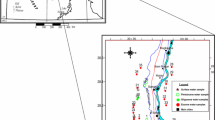Abstract
The chemical and hydrodynamic characteristics of groundwater in deltaic regions are strongly influenced by the complex stratigraphy of these areas, caused by the continuously varying depositional environments associated with their recent hydrographic evolution. As a case study, the eastern sector of the Po River plain, northern Italy, has been investigated to understand the quality of the available groundwater resources. Based on the analysis of hydrochemical and isotopic data, the recharge characteristics, the groundwater residence time and the aquifer vulnerability are defined. The results show significant qualitative degradation of the unconfined aquifer due to the shallow depth to water, while in the underlying confined aquifer, a hydrochemical facies of Ca–HCO3 type prevails. The spatial variation and relationship between oxygen-18 and deuterium determine: firstly, hydraulic separation of the two hydrogeological units; secondly, direct infiltration of local precipitation to the unconfined aquifer; thirdly, the occurrence of waters originating in the Alps and locally from the Apennines, pervading the confined aquifer. The tritium results suggest local mixing between the superficial waters and the confined aquifer, occurring along the palaeo-river channels. This increases the pollution vulnerability of the confined hydrogeological unit within the plain, which is the only natural groundwater resource exploited for water supply.
Résumé
Les caractéristiques chimiques et hydrodynamiques des eaux souterraines des régions deltaïques sont fortement influencées par la complexité stratigraphique de ces zones, résultant d’environnements de dépôt en perpétuel changement et de leur récente évolution hydrographique. Dans ce contexte, le secteur Est de la plaine alluviale du Po, au nord de l’Italie, a été étudié afin de comprendre l’origine de la qualité des ressources en eaux souterraines. Les caractéristiques de la recharge, le temps de résidence ainsi que la vulnérabilité des aquifères ont été définis sur la base de données géochimiques et isotopiques. Les résultats montrent pour l’aquifère libre une forte dégradation de la qualité des eaux souterraines due à leur faible profondeur alors que l’aquifère captif sous-jacent est dominé par un faciès hydro chimique de type Ca–HCO3. Les relations entre l’oxygène 18 et le tritium, ainsi que leurs variations spatiales, indiquent (1) une discontinuité hydraulique entre les deux unités hydrogéologiques, (2) une infiltration directe des précipitations locales dans l’aquifère libre et (3) l’existence prépondérante d’eaux originaires des Alpes, voire localement des Apennins, dans l’aquifère captif. Les analyses du tritium suggèrent des mélanges ponctuels entre les eaux superficielles et profondes à la faveur de paléo chenaux fluviatiles. Cet état de fait augmente la vulnérabilité de l’aquifère captif qui constitue l’unique ressource souterraine en eaux potable, exploitée dans la plaine alluviale.
Resumen
Las características químicas e hidrodinámicas del agua subterránea en regiones deltaicas están fuertemente influenciadas por la estratigrafía compleja de estas áreas, causada por los diferentes ambientes deposicionales que varían continuamente asociados con su evolución hidrográfica reciente. Como un caso de estudio, el sector oriental de la llanura del Río Po, en el norte de Italia, ha sido investigado para entender la calidad de los recursos de agua subterránea disponibles. En base al análisis de datos hidroquímicos e isotópicos, se definieron las características de la recarga, el tiempo de residencia del agua subterránea y la vulnerabilidad del acuífero. Los resultados muestran una degradación cualitativa significativa del acuífero libre debido a la escasa profundidad al agua subterránea, mientras que en el acuífero confinado subyacente prevalece una facie hidroquímica del tipo Ca–HCO3. La variación espacial y la relación entre Oxígeno-18 y deuterio determina: primero, una separación hidráulica de las dos unidades hidrogeológicas; segundo, infiltración directa de precipitación local al acuífero libre; tercero, la ocurrencia de aguas originadas en los Alpes y localmente en los Apeninos, invadiendo el acuífero confinado. Los resultados de tritio sugieren mezcla local entre las aguas superficiales y el acuífero confinado, lo que ocurre a lo largo de paleocauces. Esto incrementa la vulnerabilidad a la polución de la unidad hidrogeológica confinada dentro de la llanura, la que constituye la única fuente de agua subterránea natural explotada para suministro de agua.
摘要
由与近期水文演化相关的连续变动的沉积环境所造成的复杂地层结构, 强烈影响着三角洲地区地下水的化学和水动力特征。作为案例研究, 本文对意大利北部Po河平原东部进行了调查, 以了解其可采地下水资源的水质。基于水化学和同位素分析, 确定了补给特征、地下水驻留时间和含水层脆弱性。结果表明, 潜水因埋深小, 水质显著恶化 ; 而下伏承压水的水化学相以Ca-HCO3型为主。根据氢氧稳定同位素的空间变化及其相互关系, 得出 : 首先, 两个水文地质单元的水力划分 ; 第二, 当地降水直接入渗潜水含水层 ; 第三, 源于阿尔卑斯山和局部源于亚平宁山脉的水遍及承压含水层。氚结果表明, 浅层水和承压水沿古河道发生局部混合。这增加了该平原承压水文地质单元的污染脆弱性, 而该单元是作为供水开采的唯一的天然地下水资源。
Resumo
As características químicas e hidrodinâmicas das águas subterrâneas nas regiões deltaicas são fortemente condicionadas pela estratigrafia complexa destas áreas, causada pelos ambientes de deposição continuamente variáveis associados à sua evolução hidrográfica recente. Como caso de estudo para compreender a qualidade dos recursos hídricos subterrâneos disponíveis, investigou-se o sector oriental da planície do Rio Pó, norte de Itália. Com base na análise de dados hidroquímicos e isotópicos, definiram-se as características de recarga, o tempo de residência das águas subterrâneas e a vulnerabilidade do aquífero. Os resultados mostram degradação qualitativa significativa do aquífero livre, devido à profundidade baixa à água, enquanto que, no aquífero confinado subjacente, prevalece uma fácies hidroquímica do tipo Ca-HCO3. A variação espacial e a relação entre o oxigénio-18 e o deutério determinam: primeiramente, separação hidráulica das duas unidades hidrogeológicas; em segundo lugar, infiltração directa da precipitação local no aquífero livre; em terceiro lugar, a ocorrência de águas com origem nos Alpes e localmente nos Apeninos, penetrando no aquífero confinado. Os resultados do trítio sugerem mistura local entre as águas superficiais e o aquífero confinado, ocorrendo ao longo dos canais do paleo-rio. Isto aumenta a vulnerabilidade à poluição da unidade hidrogeológica confinada dentro da planície, que é o único recurso hídrico subterrâneo natural explorado para abastecimento de água.













Similar content being viewed by others
References
AGIP Mineraria (1959) Campi gassiferi Padani. [Gas fields in the Po Plain] In: I giacimenti gassiferi dell’Europa occidentale [The gas fields of western Europe], Accademia Nazionale dei Lincei ed ENI, vol 2, Atti del Convegno di Milano, 30 September, 5 October 1957, Rome, pp 45–497
Albarello D, Martinelli G (1994) Piezometric levels as possible geodynamic indicators: analysis of the data from a regional deep waters monitoring network in northern Italy. Geophys Res Lett 21:1955–1958
Amorosi A, Centineo MC, Colalongo ML, Fiorini F (2005) Millennial-scale depositional cycles from the Holocene of the Po Plain, Italy. Mar Geol 222–223:7–18
Autorità del bacino del fiume Po [Authority for the hydrographic basin of the Po River] (2007) Database. ADBPO, Parma, Italy. http://www.hortus.it/adbpo/Dett_sezFiume.asp?sez=11. Cited 22 September 2008
Bellardone GF, Bonfanti F, Coggiola F, DeLucca D, DiGoia M, Governa ME, Masciocco L, Oliviero GF, Pasqualotto M, Ricci P, Surace F, Zauli M, Zuppi GM (1987) Isotope hydrology in Po valley. Stud Geol pianura Padana 3:1–22
Bondesan M (1990) L’area deltizia padana: caratteri geografici e geomorfologici [The delta area of the Po Plain: geographic and geomorphologic characteristics]. In: Il Parco del delta del Po, Studi ed Immagini’[The Park of the Po delta], Spazio Libri, Ferrara, Italy, pp 9–48
Bottoni A (1873) Appunti storici sulle rotte del basso Po, dai tempi Romani a tutto il 1839 [Historical notes on the flooding events along the low Po River, from Roman times to 1839]. Tipografia Sociale, Ferrara, 221 pp
Bortolami G, Fontes JCh, Panichi C (1973) Isotopes du milieu et circulations dans les aquiferes du sous-sol Vénitien [Isotopes of the sediments and circulation in the aquifers of the Venetian underground]. Earth Planet Sci Lett 19:154–167
Bortolami C, Braga G, Colombetti A, DalPra A, Francani V, Francavilla F, Giuliano G, Manfredini M, Pellegrini M, Petrucci F, Pozzi R, Stefanini S (1978) Hydrogeological features of the Po Valley (northern Italy). In: Proc. of the IAHS conference on hydrogeology of great sedimentary basins, Budapest, Hungary, 31 May–5 June 1976, pp 304–321
Bortolami GC, Ricci B, Sella GF, Zuppi GM (1979) Isotope hydrology of the Val Corsaglia, maritime Alps, Piedmont, Italy. In: Isotope hydrogeology 1978, vol I, IAEA, Vienna, pp 327–350
Bortolami GC, Olivero GF, Piovesana F, Ricci B, Zuppi GM (1983) Idrogeologia isotopica della pianura vercellese-novarese (Piemonte) [Isotope hydrogeology of the Vercelli-Novara plain (Piedmont)] Accademia Nazionale dei Lincei, Rendi Class Sci Fisich Chim Natur LXXIV/3:157–166
Carlin F, Cervellati A, Gonfiantini R, Magri G (1975) Use of environmental isotopes to investigate the interconnections between the Reno River and groundwater (northern Italy). Isotope ratios as pollutant source and behaviour indicators. IAEA-SM-191/6, IAEA, Vienna, pp 179–194
Chahoud A, Fava A, Martinelli G (2002) Indagine di idrologia isotopica [Investigations on the isotopic hydrology]. Regione Emilia-Romagna, ARPA, Bologna
Cassano E, Anelli L, Fichera R, Capelli V (1986) Pianura Padana: interpretazione integrata di dati geofisici e geologici [Po Plain: integrated interpretation based on geophysical and geological data]. 73° Congresso della Società Geologica Italiana, Roma, 30 September–4 October 1986
Cipriani F (1988) Hydrography in the lowland of the Po valley and the settlement there. Ann Univ Ferrara, sezione Vi-Lettere I(1):1–21
Conti A, Sacchi E, Chiarle M, Martinelli G, Zuppi GM (2000) Geochemistry of the formation water of the Po plain (Northern Italy): a review. Appl Geochem 15:51–65
Freeze RA, Cherry AJ (1979) Groundwater. Prentice-Hall, Englewood Cliffs, NJ, 604 pp
Gorgoni C, Martinelli G, Sighinolfi GP (1982) Isotopic evidence of paleowaters in the Po sedimentary basin (northern Italy). Geochem J 16:51–61
Gubellini A, Russo P (1988) Controllo di una “faglia” nell’abitato di Correggio [Fault control in the Correggio settlement]. Studi e ricerche, Istituto di Topografia Geogesia e Geofisica Mineraria, Bologna, Italy, pp 313–329
Hem JD (1985) Study and interpretation of the chemical characteristics of natural water, 3nd edn. US GeolSurv Water Suppl, Pap 2254, 263 pp
Hounslow AW (1995) Water quality data: analysis and interpretation. Lewis, New York
International Atomic Energy Agency (IAEA) (2000) www.iaea.org. Cited December 2000
IPCC (2001a) Climate change 2001: The scientific basis, Contribution of Working Group I to the Third Assessment Report of the Intergovernmental Panel on Climate Change, Cambridge Univ. Press, Cambridge, 881 pp
IPCC (2001b) Climate change 2001: Impacts, adaptation and vulnerability, Contribution of Working Group II to the Third Assessment Report of the Intergovernmental Panel on Climate Change, Cambridge Univ. Press, Cambridge, 1005 pp
Lloyd JW, Heathcote JA (1985) Natural inorganic hydrochemistry in relation to groundwater. Oxford Univ. Press, New York
Longinelli A, Selmo E (2003) Isotopic composition of precipitation in Italy: a first overall map. J Hydrol 270:75–88
Martinelli G, Minissale A, Verrucchi C (1998) Geochemistry of heavily exploited aquifers in the Emilia-Romagna region (Po Valley, northern Italy). Environ Geol 36(3–4):195–206
Mitchell T, Hulme M (2000) A country-by-country analysis of past and future warming rates. Tyndall Centre Internal Report 1, November, UEA, Norwich, UK, 6 pp. http://www.tyndall.ac.uk/publications/working_papers/wp1.pdf. Cited 22 September 2008
Molinari FC, Boldrini G, Severi P, Duroni G, Rapti-Caputo D, Martinelli G (2007) Risorse idriche sotterranee della Provincia di Ferrara [Underground water resources of the Ferrara Province]. Regione Emilia Romagna, DB-MAP. Florence, Italy, pp 5–61
Palutikof JP, Wigley TML (1996) Developing climate change scenarios for the Mediterranean region. In: Jeftic L, Milliman JD, Sestini G (eds) Climatic change and the Mediterranean, UNEP 1. Arnold, London, pp 27–56
Palutikof JP, Trigo RM, Adcock ST (1996) Scenarios of future rainfall over the Mediterranean: is the region drying? In: Proceedings of Mediterranean Desertification, Research Results and Policy Implications, vol 1, Crete, 20 October to 1 November 1996, pp 33–39
Pearson FJ Jr (1965) Use of C-13/C-12 ratios to correct radiocarbon ages of material diluted by limestones. In: Proc of the 6th Int. Conf. on Radiocarbon “Radiocarbon and tritium dating”, Pullman, Washington, June 1965, pp 357–366
Pellegrini M, Vezzani L (1978) Faglie attive in superficie nella Pianura Padana presso Correggio (Reggio Emilia) e Massa Finalese (Modena) [Superficial active faults in the Po Plain near Correggio (Reggio Emilia) and Massa Finalese (Modena)]. Geogr Fis Dinam Quat 1:141–149
Pieri M, Groppi G (1981) Subsurface geological structure of the Po plain, Italy. CNR report no. 414, Consiglio Nazionale delle Ricerche, Rome, 23 pp
Pilla G (1998) Hydrochemical and geochemical isotopic characterization of ground water resources in the underground of Pavia (south western lombardy, italy). Atti Ticinensi Sci Terra 40:185–201
Pilla G, Sacchi E, Zuppi G, Braga G, Ciancetti G (2006) Hydrochemistry and isotope geochemistry as tools for groundwater hydrodynamic investigation in multilayer aquifers: a case study from Lomellina, Po plain, south-western Lombardy, Italy. Hydrogeol J 14:795–808
Piper AM (1944) A graphical procedure in the geochemical interpretation of water analyses. Trans Am Geophys Union 25:914–923
Rapti-Caputo D (2000) Risorse idriche sotterranee a est di Ferrara: indagini sul comportamento idrogeologico e idrochimico. Proposte per una gestione ottimale [Underground water resources east of Ferrara: investigations on the hydrogeological and hydrochemical behaviour: proposal for the best management]. PhD Thesis, University of Ferrara, Italy, 215 pp
Rapti-Caputo D (2005) Geochemical evolution and management of an alluvial aquifer system. G Geol Appl 2:369–376. doi:10.1474/GGA.2005–02.0–54.0080
Rebai S, Philip H, Taboada A (1992) Modern tectonic stress field in the Mediterranean region: evidence for variation in stress direction at different scales. Geophys J 110:106–140
Regione Emilia-Romagna, ENI-AGIP (1998) Riserve idriche sotterranee della regione Emilia-Romagna [Underground water reservoirs in the Emilia-Romagna region]. S.EL.CA., Florence, 120 pp
Stefani M, Vincenzi S (2005) The interplay of eustasy, climate and human activity in the late Quaternary depositional evolution and sedimentary architecture of the Po Delta system. Mar Geol 222–223:19–48
Stumm W, Morgan JJ (1981) Aquatic chemistry, 2nd edn. Wiley, New York
Tinti S, Santarato G, Vianelli S, Dall’Olio L (1994) Prospezioni sismiche e geoelettriche mirate alla determinazione di strutture superficiali in località Casaglia (Fe) [Seismic and geoelectrical surveys devoted to the recognition of superficial structures in locality Casaglia (Fe)]. In: Atti del 137 convegno gruppo nazionale geofisica della terra solida. CNR (Italian National Research Council), Rome, pp 607–619
US Environmental Protection Agency (1974) Manual of methods of chemical analysis of water and wastes. EPA Technology Transfer, USEPA, Washington, DC
Veggiani A (1974) Le variazioni idrografiche del basso corso del fiume Po negli ultimi 3000 anni [The hydrographic variations along the low Po River during the last 3000 years]. Padusa, Rovigo, Italy, pp 1–22
Zuppi GM, Bortolami GC (1982) Hydrogeology: a privileged field for environmental stable isotopes application: some Italian examples. SIMP 38(3):1197–1212
Zuppi GM, Sacchi E (2004a) Hydrogeology as a climate recorder: Sahara (North Africa) and the Po Plain (northern Italy). Glob Planet Change 40(1/2):79–91
Zuppi GM, Sacchi E (2004b) Dynamic processes in Venice region outlined by environmental isotopes. Iso Envir Health Study 40:1–11
Acknowledgements
Thanks to Arpa Regione Emilia Romagna for hydrometric and piezometric data, and to the Ro Ferrarese agency for the pumping tests data and for permission to sample the wells. Thanks also to Dr. E. Zagana of the National Center for Marine Research of Greece for analytical support. Thanks are also due to G.M. Zuppi for useful discussions on isotopic data.
Author information
Authors and Affiliations
Corresponding author
Rights and permissions
About this article
Cite this article
Rapti-Caputo, D., Martinelli, G. The geochemical and isotopic composition of aquifer systems in the deltaic region of the Po River plain (northern Italy). Hydrogeol J 17, 467–480 (2009). https://doi.org/10.1007/s10040-008-0370-6
Received:
Accepted:
Published:
Issue Date:
DOI: https://doi.org/10.1007/s10040-008-0370-6




